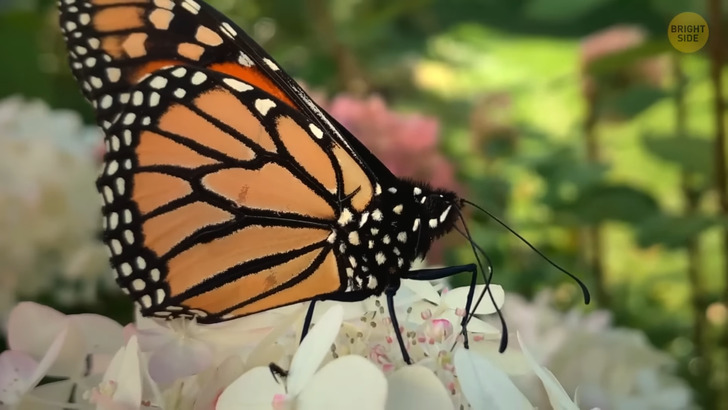10 Single Parents Who Got Knocked Down but Refused to Stay There

Poor Pete. Pete is so scared of bugs all he wants is to find a place on Earth where he can be safe from them. After years of research and traveling, he eventually finds the place to go: Antarctica!
Pete makes it there, confident that bugs wouldn’t survive in the cold. Ahhhhhhh! Little did he know that insects are on every continent of this planet. Well, not really.
He was kind of right about Antarctica: it isn’t home to a lot of bugs. In fact, there is only one true species of insect that calls this place home: it’s a wingless midge called Belgica antarctica. This fly is tiny [0.08 to 0.23 inches long], but it’s still Antarctica’s largest terrestrial bug.

Ok, so we’ve established there’s literally no place on Earth you can escape insects. Well, that’s not actually true, either. You might need to learn to swim, though, as the only place that doesn’t have any bugs living within is the Earth’s surface covered by the ocean. But why do insects hate it here so much?
No one could really come up with a definitive explanation, but some think it’s because the oceans lack the plants that insects use for food and shelter. They might as well be the largest network of secret agents on the planet, as insects have ears all over the place. Most of the time, though, these ears are not on their heads. Some have ears on their wings, some on their legs, and some even on their abdomen and necks.
A lot of these bugs live pretty lonely lives, but there are some of them that actually have families! Like the bess beetles, for example. They can form family-like units, in which both “parents” work to raise their young. They also have their own vocabulary and speak to each other by squeaking.
Should an insect ever fall from a certain height, does it sustain any damage? Well, the subject is a bit more complex, but let’s take ants for example. They don’t take any fall damage, and that’s because they’re so small. A lot of other bugs can technically fall from a height of miles and still be fine.

The explanation has a lot to do with Math and Physics, which the bugs themselves have no time to study, but to put it simply, they’re not nearly heavy enough to impact the surface they hit. As they fall, they don’t actually gather speed: they slow down. An ant’s relatively large surface area — for that tiny weight — creates a lot of drag as it moves through the air, so it ends up slowing down as it reaches the end of its flight.
Speaking of ants, (wasn’t I doing that?) there are about 1 quadrillion of them on the planet at any given moment. That’s about 1.4 million ants per human, calculated for a world population of 7.3 billion people. If we put it that way, it’s their planet, right?
It’s hard to imagine a fruit fly with an astronaut helmet on, but they were indeed the first living creatures to be launched into space. That was back in 1947, when they waved goodbye to the Earth in a V-2 rocket, reaching an altitude of about 68 miles in less than 200 seconds. They then returned to Earth by parachute. Not all insects are that lucky.
For example, caterpillars have a total of 12 eyes but are basically blind. Their simple little eyes can only distinguish between light and dark. So, they can’t actually see a clear picture of what’s in front of them. And no, glasses won’t help if that’s what you’re thinking. Some insects actually put a lot of work into their, ehm, dating life. A good example is the stoneflies, which do push-ups to attract the ladies.

Did you know butterflies taste the surroundings with their feet? Heard that right. That’s because they have taste sensors on their feet that help them find food. So, they stand on a leaf and give it a taste. If they figure out the plant is something their caterpillars can eat, they’ll place their eggs in this spot.
But how do they eat since they can’t bite or chew? They use their long tongue, which looks more like a tube, called a proboscis. It’s basically a straw that helps butterflies to slurp up liquids, like nectar, for example. The ancestors of this crafty creature had lived on this planet way before the dinosaurs themselves! Fossil records show that ancient grasshoppers first came up more than 300 million years ago.
Ever heard of bugs that are fans of rock music? Well, in a way, termites do — sort of — prefer this sound. Termites chew away at wood to figure out what kind of wood they have lying around. They use vibrations. Why? Because it helps them find the best source of food. If there’s heavy metal or rock music playing, they can chew through the wood faster than at their regular speed. Hmm. Do they slow their chewing down with Brahms or Bach? Or just go to sleep?

This is one type of insect you’ll surely find difficult to see. This master of disguise, the Phylliidae bug, looks like a leaf. Throughout their existence, they managed to develop this type of camouflage, so the predators miss them in plain sight. They can even rock back and forth to copy the movement made by leaves blown by the wind.
Nature has its own weather forecasters: the mighty crickets! Well, they work more like a thermometer if you like. Turns out you can manually calculate the temperature outside by counting the cricket chirps you hear in a minute and then divide it by 4. You should then add 40 to that number you get, and there you have it, an estimated temperature number in Fahrenheit. Crickets even have their own unique song, which they use to attract mates and defend their territory. Yes, music that repeals and attracts at the same time.
You should consider ladybugs if you’re interested in free gardening services. That’s because they feed on other insects — some that can actually damage your plants. They can keep fruit flies and other mites at bay. A ladybug might end up eating more than 5,000 insects in its lifetime — which adds up to about a year.

Let’s get into some awesome data about the busy bees. Their wings can beat 190 times per second. I’ll do the math for you. That’s 11,400 times a minute. What a workout! Well, they do need that strength since a single honeybee colony can produce around 220 pounds of honey each year. That’s a staggering 220 jars! It’s nature’s equivalent of a factory! But you’d have to teach bees to make honey. It’s not in their instinct to do so.
Another fascinating aspect of bees’ life is that the temperature inside any beehive is always around 93 degrees, regardless of the outside weather. That’s because they’re really good at insulating their surroundings. Bees also have different stomachs for eating and for storing honey. It’s the bee’s equivalent of not doing business while you’re eating.
Ok, don’t jump out of your chair just yet, as you might actually enjoy some of these facts about spiders. They do help a lot with maintaining our crops free from other insects, so if you think about it, we do have something to thank them for. Their eyesight is also incredible. They can see spectrums of light that we can’t: like UVA and UVB light. And speaking of their superpowers, a strand of spider silk is five times stronger than a strand of steel — of the same thickness, of course.
Some scientists believe that if spiders were as large as humans — certainly hope not! — their web could stop objects as big as airplanes. And that spider silk? It’s actually a liquid, but it does harden when exposed to the air. They’re also quite sneaky themselves and have evolved to look more like ants. Why? So they can better avoid other predators and hunt ants better. Spiders don’t have wings, that’s for sure, but the jumping ones can hop up to 50 times their own length. Otherwise, I still get the heebie-jeebies when I think about spiders. How about you?











